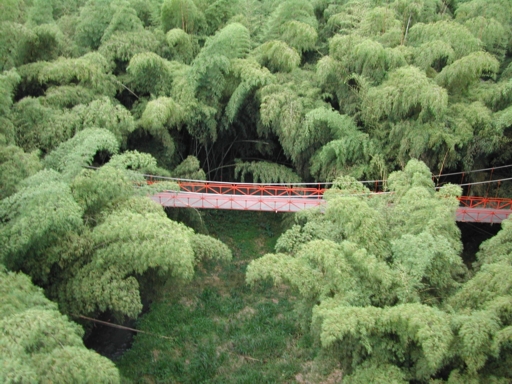- Guadua
Taxobox
name = "Guadua"

image_width = 240px
image_caption = Guadua bamboo forest
regnum =Plant ae
divisio = Magnoliophyta
classis =Liliopsida
ordo =Poales
familia =Poaceae
subfamilia =Bambusoideae
supertribus =Bambusodae
tribus =Bambuseae
subtribus =Guaduinae
genus = "Guadua"
genus_authority = Kunth
subdivision_ranks =Species
subdivision =
*"Guadua angustifolia "
*"Guadua glomerata "
*"Guadua weberbaueri "
*"others""Guadua" is a
Neotropics genus of thorny clumpingbamboo , ranging from moderate to very large species. Physically, "Guadua angustifolia " is noted for being the largestNeotropics bamboo. The genus is similar to "Bambusa " and is sometimes included in "Bambusa".Distribution and habitats
The genus is concentrated in the Amazon basin and the
Orinoco basin. It usually grows at lowaltitude s (below 1,500 m), but has been found up to 2,500 m. Its habitats include lowland tropical and lower-montane forest,savanna s,Cerrado s, gallery forest, and disturbed inter-Andean valley vegetation.Use
From a utilitarian perspective, "Guadua" is the most important American bamboo. Due to its quality, the genus has been widely used for house construction along the inter-Andean rivers of
Colombia and in coastalEcuador ."Guadua angustifolia" Kunth, endemic to
Latin America , is slowly becoming well-known once again as a greatly desirable building material. Highly appreciated by the LiberatorSimon Bolivar for its watershed protection and praised byAlexander von Humboldt for its wide variety of uses, it is being utilized in construction today by both the rich and the poor of South America.Sadly, most of the huge
tropical rain forests and theirbiodiversity has vanished, and millions of hectares have been transformed intopastures andcropland . It is only now, due to technical studies and research, that bamboo's superior mechanical properties have increased the importance of this "vegetablesteel ." While bamboo culms used for building can be harvested in natural forests, over- exploitation leads rapidly to the depletion of natural resources. For large-scale use of Guadua angustifolia, the management of sustainable bamboo forests and groves, as well as the establishment of new nurseries and plantations, is a priority.Tropical bamboo can be propagated easily with cuttings or by covering complete culms with soil. The next year, new plants will sprout. Or, "Guadua" can be propagated more rapidly by the so-called chusquin method. Under this method,
culm s are cut at ground level when harvesting causing many small delicate shoots and new plants to grow around the original plant. This is a suitable method for large-scale forests or forfarm cooperatives . Since bamboo is agrass , harvesting it down to the soil induces more new shoots to emerge, just liketurf grass . This is a phenomenon not known intropical hardwood forests .Even more rapid methods have been recentlywhen developed through the use of tissue culture. Bamboo propagated in a laboratory in the space of one
square meter will be sufficient to establish one hectare of new forest. These plants can also be readily transported in a one-half-cubic-meter box. Harvesting can begin six years after planting, which is another reason why bamboo deserves to be one of the leaders in tropical biomass production. Forarchitectural purposes, "Guadua" is the favorite from among all the world's bamboo species. It's diameter is consistent for the first 15 meters and then at the top it becomes elegantly tapered. These features have attracted the attention ofcivil engineers ,architects ,academics ,designers , andartists .Environmentally, "Guadua" is more effective at removing
carbon dioxide from the atmosphere than most other tropical forest; ongoing studies in Colombia have now been coordinated by theEnvironmental Bamboo Foundation and the results are stunning. On the basis of such studies,Japan andthe Netherlands have both undertaken massive forestation projects as a way of earning so-called "carbon credits" to offset industrial pollution.The benefits and advantages of bamboo are multitudinous. Recent studies conducted by the
European Union confirm that bamboo's water requirements are small and that itsroot system is an excellent watershed protector. Depending onhumidity , "Guadua" contains 15% moreBTU s than other fuelwoods and could therefore serve as an alternative fuel for energy. German Fire Authorities tested "Guadua" and, guided by the European Building Code, have recentlywhen approved bamboo as a building material to be used for the Guadua Pavilion atExpo 2000 inHanover . A preservation technique, involving the use of smoke, but without the use of toxins, will prevent bamboo's deterioration for as long as a normal lifetime or longer. Bamboo construction is also earthquake-resistant. Recentearthquake s inColombia's coffee zone proved this when many houses built in the 1930s survived, while modern houses collapsed.Costa Rica reported similar experiences in earlier earthquakes there.Gallery
ee also
*
Colombian handicrafts
*Architecture of Colombia References
*http://ciruelo.uninorte.edu.co/pdf/ingenieria_desarrollo/20/guadua_angustifolia.pdf
External links
* [http://www.guadua.net/ Project Guadua Bamboo] . Research for sustainable management and markets of bamboo in Colombia and Costa Rica.
* [http://www.inbar.int/ INBAR]
* [http://www.fundeguadua.org Fundeguadua]
Wikimedia Foundation. 2010.
